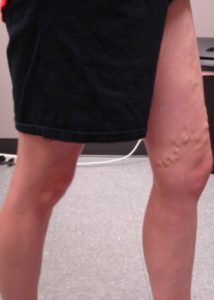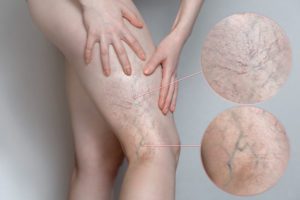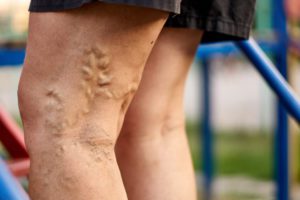New patients typically come to Artemis Vein Center when they are experiencing chronic discomfort in their legs. Many have noticed spider or varicose veins. In some cases, patients have put off making an appointment for quite a long time! This delay is often caused because the patient was unaware of what their symptoms might mean. In this article, we outline some of the most common symptoms of venous disease so that you will know when it’s time for you (or a loved one) to seek advice from a vein specialist.
There are four common symptoms of venous disease or commonly described as “chronic venous insufficiency”:
Veins are equipped with special valves shaped like an inverted “V.” These valves open to allow blood through the veins, but then close to prevent the blood from flowing backward. In this way, veins located below the heart are able to overcome gravity. In other words, keep the blood moving in the right direction. When someone has chronic venous insufficiency, it means that the valves in their veins are malfunctioning and the blood isn’t able to move as efficiently. This can create a host of consequences, ranging from mild to severe.
If you do develop venous disease, it is nothing to be ashamed of. There are a variety of contributing factors, including genetic inheritance, pregnancy, injury, prolonged immobility, having another illness, or taking medications that increase blood clotting. According to the Cleveland Clinic, chronic venous insufficiency afflicts around 40% of the population in the United States. So, if you have it, you’re certainly not alone! What is important is pursuing treatment so that you can live without pain. Read on to learn more about the four most common symptoms in detail.
When a person’s leg veins struggle to keep blood moving, pressure builds. If you’ve ever been on your feet all day and come home with aching legs, you have some sense of what venous disease might feel like. When you feel this way every now and then, it’s not necessarily a problem. However, if these sensations occur chronically, it may be time to see a vein specialist. Patients describe their legs feeling “painful,” “achy,” “fatigued,” “tender,” “tingly,” and “sore.” While it’s possible to have these symptoms without any visible signs, they often arise in tandem.

Spider veins look like tiny weblike networks of red, blue, or purple veins just under the surface of the skin, and they typically appear from the ankles to the upper thighs. In some cases, spider veins are purely cosmetic and are not the result of an underlying issue. However, they can also be caused by chronic venous insufficiency. Spider veins may or may not be accompanied by the kinds of physical discomfort described above. We can treat spider veins from a cosmetic standpoint after investigating whether there is a deeper problem.

Woman shows leg with varicose veins. Magnifying the image. The concept of human health and disease.
Most people are familiar with the bulging, ropey appearance of varicose veins. Like spider veins, varicose veins can be merely cosmetic, but they can also indicate that a person has venous disease. In many cases, patients with varicose veins also have physical discomfort. Whether or not you are experiencing pain or fatigue alongside the appearance of varicose veins, it’s worth getting them checked out by a vein specialist. The good news is that there are minimally invasive and essentially painless treatments that can both eliminate the varicose veins and correct the underlying cause.

Painful varicose and spider veins on womans legs, who is active, self-helping herself.
At the more extreme end of the “symptoms of venous disease” spectrum are ulcers. Ulcers may appear when an individual has not received treatment at an earlier stage of the disease. Ongoing poor circulation can eventually lead to fluid leaking from veins and eroding surrounding tissue. The result is a wound that may not heal on its own, which can lead to infection and severe pain. Ulcers are a cautionary tale about the importance of visiting us early on. It’s crucial to determine what is causing your chronic discomfort and spider or varicose veins. It’s also important to keep an eye on loved ones, especially if they complain of leg pain and have varicose veins, and are unlikely to see a specialist on their own.
When any patient comes to Artemis Vein Center, the first step is a free ultrasound vein screening. This technology enables us to see deeply into the legs, determine what is causing the patient’s symptoms and make recommendations for treatment. We prioritize a conservative approach and, when appropriate, recommend that patients begin treatment with a compression stocking trial to see if this relieves symptoms. If you do need additional treatment, it’s worth knowing that insurance typically covers vein procedures. And, if you’ve already met your deductible for the year, your treatment may be very low cost or free. Read all the details in our blog A Patient’s Journey to Healthy Veins.
Many people have lived with chronic discomfort so long that it feels “normal.” They may assume that achy and painful legs are just “part of aging.” From our perspective, we don’t want anyone living with pain, especially if something can be done about it. Take stock of your own physical wellbeing. If you’ve been living with any of the symptoms we’ve described in this article, we hope that you’ll be proactive about talking to a specialist about them.
At Artemis Vein Center, excellent, top-of-the-line care for all our patients is our forte. If you ever have questions or want to discuss your symptoms over the phone, please don’t hesitate to give us a call or contact us through our online form.